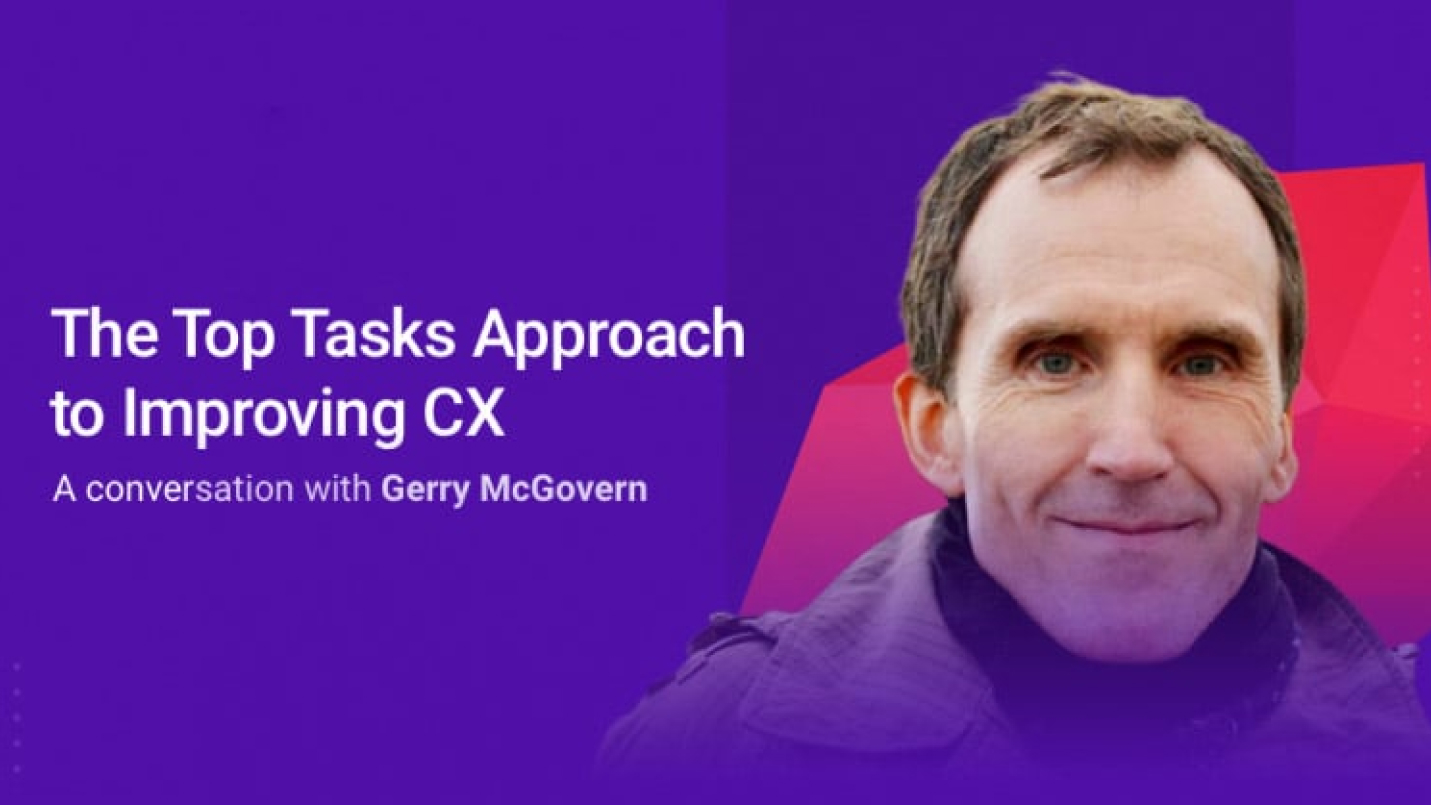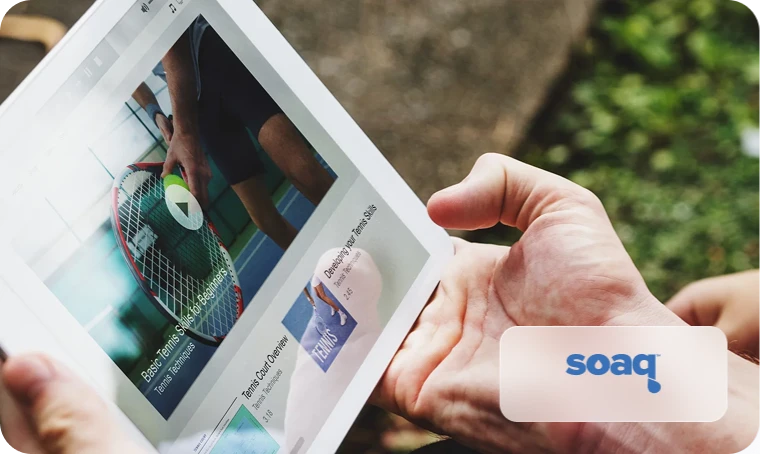Gerry has developed Top Tasks, a customer experience management model, over 15 years of research and experience. He helps large organizations deliver a better digital customer experience. His commercial clients include Microsoft, Dropbox, Cisco, NetApp, VMware, and IBM. He has also consulted with the US, UK, EU, Dutch, Canadian, Norwegian, and Irish governments.
The Irish Times has described Gerry as one of five visionaries who have had a major impact on the development of the Web. He has appeared on BBC, CNN, and CNBC television; participated in various radio shows; and featured in numerous print publications. He is the founder and CEO of Customer Carewords.
We recently caught up with Gerry for insights on customer experience. Here we present excerpts from the conversation:
Abhay: First, I would like your introduction, so what would you say is your job title?
Gerry: I suppose, in a way I am a consultant and I develop these Top Task methods which is the essence of what I do. I speak about it and work with partner companies to implement it. But I suppose the essential stuff I do is between a consultant and a writer.
Abhay: Sounds good. So is your Top Tasks approach more of a customer experience improvement strategy?
Gerry: Yeah. Broadly it is about managing around what the customer needs to do rather than trying to force the customer to do things. It is more about managing the customer experience based on their top tasks, on the core things that they need to achieve.
Abhay: I was looking through your website and what struck me was that it’s remarkably free of any buzzwords. How did you manage that?
Gerry: I have published seven books at this stage and I am trying to keep things simple and speak directly to people. I try to explain things as simply as possible. That is something that I have been trying to achieve for a number of years.
I’m glad that you found the content relatively simple and straightforward. It is a process of continuously trying to think like the customer and explain things in the simplest way possible.
Abhay: Yes, I did find that your content was easy to understand. And when I was going over it, I was wondering what a simple approach it is and why hasn’t anyone else thought of it. From what I understand, you basically identify the top tasks. I would love to know more about this approach. What are the research methods and practices that you use to identify these top tasks. What methods do you use? Is qualitative or quantitative data also involved?
Gerry: Yeah! Well in identifying the top tasks, it is a quantitative approach. And, partly why other people did not initially adopt it (although it has now been used more than 50 times in more than thirty countries and languages) is that the Top Tasks methods initially seems strange and counter-intuitive. You start off by collecting all the potential tasks initially, that a customer might have in choosing a car or deciding on a university, for example. Or, whatever the problem that they may have. And, that list of tasks may be from anywhere from 50 to 80 things that really matter to them.
Now, this is the ‘crazy’ part. We present the entire list in a random order to people and get them to vote and choose no more than five. So, it is quite an unusual survey method and a lot of people think that it can’t work. But it does work. It’s worked for organizations such as Microsoft, IBM, Cisco, Toyota, Google.
When we get three or four hundred people to vote on that list, we get very solid and statistically reliable data.
Abhay: So at any stage in this do you also make use of the card sorting, that is, basically writing things on cards and asking customers to sort them?
Gerry: No, not in the task identification process. It is kind of related to card sorting but it is not the same. It is essentially getting down in one list all those things the potential list of things that would really matter.
We assemble a survey where customers can choose what is most important to them. What it gives you is a league table of what is important. So, you get the most important task to the least important task. And, every time we do it, we see an effect that we call the “long neck.” A small set of tasks will get vastly more votes than everything else. So, you know that the relatively small set of tasks that get a huge percentage of the vote.
Abhay: And, another thing I wanted to understand is if the top tasks refer only to interactions within a digital touchpoint, like a website or mobile app, or do you also take into account any interactions done in the physical world?
Gerry: No, it’s not about a website or a channel. It’s about identifying what matters most to people in buying a car or choosing a university, or a piece of software.
We recently did a project for Toyota and it was about how you buy a car. What matters most to you when you are buying a car? And, let’s say you discover that service cost, warranties, or features & specifications are the top tasks. If these are the essential things that matter most, then the next decision is what is the best channel, i.e., how are people finding out about these things that matter to them. What’s the right channel? So the tasks sit at the top of the digital experience or customer experience hierarchy and then you decide what is the best way to help somebody find out, for example, the service cost for their car.
It’s not about managing the channel, but rather about managing the task.
Abhay: So companies are basically now moving more and more towards a digital and self-service model where customers are able to do things on their own. But, still there are instances where the customer needs to go to other channels, needs to shift the channel from digital to physical, say for example, calling a call-center for a specific piece of information. Or, goes and visits the car dealership for taking a test drive of the car. When the customer is going cross-channels while completing a task, how do you take that into account in the top tasks?
Gerry: Well the principle is that you manage the tasks not the channels, so you manage “test drive” and the first two steps get done online but the next two steps are physical. But, you manage the entire task rather than the channel because too many organizations manage their channels and that creates silos and often a disjointed experience. The Top Tasks approach is to manage the task and not the content, not the digital, not the physical. You manage the fact that they want to get a test drive and success is that they really have a good experience test driving the car.
So, it is not focused on channels. It is focused on tasks. It is a different model of management. So, some of the tasks maybe online (digital) and some of them maybe offline.
Abhay: Sometimes there are different teams in companies who own different steps of this entire process. From the customer point of view, it is just one journey, like if he wants to take a test drive, but internally the organization is divided into different departments and each of them are responsible for one part of the entire customer journey. Do you see that as a problem and how to fix that problem?
Gerry: Yeah. It is a huge problem, it is probably “the” problem facing organizations in delivering excellent customer experience. In the modern world most of the organizations are broken. They have got a model of organization that is more suited to the industrial age and not the digital age and it is full of silos and they all look like car factories from Henry Ford’s time where one piece gets partly made and then it gets passed on to another area, etc.
And, that does not work when it comes to customer experience. This is a huge problem globally for organizations that they are constantly stuck in silo thinking and often a bad customer experience occurs in the transition point between two silos when a task is being passed over.
And the way to get around it is to change the metrics and to measure and to create joint metrics that unify the silos around the task. So if the person doesn’t get the test drive or if the car is not ready at the time when they arrive, then everybody fails. Success is success for the customer. You measure based on customer success, i.e., whether the customer completed their task. If they haven’t completed their task then everybody fails and everybody doesn’t get their bonus. I guarantee you that if people are measured that way they will be focussed on working together because they know that either they will succeed together or they will fail together.
Abhay: I was actually going over one of the chapters from your book “Transform: A Rebel’s Guide for Digital Transformation,” and it talks a lot about culture. I believe that the organizational culture is also one of the things that needs to change if we wish to become more customer-centric.
Gerry: Well, totally. The culture reflects the organization’s structure so you get a culture of protecting the silo.
People who care a lot about their section or department often neglect the needs of the overall organization, so the culture becomes very tribal or silo based.
The culture and the organizational structure are often very intertwined. Flatter organizations have flatter cultures and hierarchical organizations have hierarchical cultures. So the structure and the metrics within the organization have a huge contribution to the culture.
They are kind of very intertwined in a way that if you change the metrics and you change the organizational structure, you will very quickly change the culture of the organization as well.
Abhay: So going back to one of my earlier questions about qualitative and quantitative research. I believe that your method is more quantitative, i.e., survey based related to collection of all the data.
Gerry: We have a couple of other methods that we have as well but the core one for task identification is quantitative. So we need a minimum number of people voting and so it gives you statistically reliable data and says that this task is forty times more important than other tasks, for example.
Abhay: Does it also involve any qualitative research in the form of customer interviews or customer shadowing.
Gerry: Yeah. It may occur in the preliminary stage where you are developing the task list. So when you are developing the task list that people are going to vote on, you are going to look also into all sorts of research and customer interviews and support calls and previous research and top searches and most visited pages and social media commentary. So in collecting the list of tasks that people will vote on, there is a lot of so to speak qualitative interaction with the customers in order to help, understand, and define what is the set of tasks that people will vote on.
Abhay: I also read somewhere that you also conduct usability testing sessions, remote usability testing where you ask the customers to do some tasks and then you observe them.
Gerry: Yeah. So the first stage is task identification. And, the next is what we call as the Task Performance Indicator. So we take the top tasks and we create task instructions.
Cisco is a good example. We have done a lot of work for Cisco over the years. The top task in Cisco was downloading software because most of the people who use Cisco are network engineers. So we come up with examples of downloading software like “download the latest firmware for the RV042 router”. Once we come up with examples of the top tasks we measure them. To do that, we give them to a sample of customers in a very structured manner. Then we would come up with success rates and time on tasks.
First, we identify the top tasks and then we measure the top ten or so tasks using the Task Performance Indicator. So, that’s the next stage after you have identified the tasks. Then from that, you get key findings like we have got a 60 percent failure rate for this task, the reasons for the failure rate are A, B, and C, and the recommendations to fix those are X, Y, and Z.
Abhay: All right. Please carry on.
Gerry: So phase one is the task identification. Then phase two is the Task Performance Indicator. And, then sometimes there is a phase three. That is an architecture design phase where we take the top tasks’ data and we design a customer-centric architecture, a navigation system based on the top task data.
So, there are three core services:
- Task Identification, which is the foundational phase
- Task Performance Indicator which measures the top tasks and comes back with management metrics about success rate and time on task
- Customer Architecture where we design an intuitive navigation for the organization using the top tasks data.
Abhay: Your approach is very similar to what we call “customer journey mapping,” so do you also think that this is basically related to customer journey mapping?
Gerry: Yes, it is definitely interlinked and has a connection for sure. There are definitely relationships with customer journeys and journey mappings and stuff like that. This takes a slightly different approach in first establishing clearly what the top tasks are and what the tiny tasks are. Because what we find that a lot of organizations are mapping the wrong tasks and that they are focussing on the tiny tasks or the low value tasks for the customers because those are sometimes politically valued within the organization. But the customer does not care. Top Tasks sets the foundation that says, “Lets focus first and foremost on the top task.”
Abhay: So, I have come across many tools that claim to be customer journey mapping or customer journey analytic tools. I haven’t personally used any one of them but there are tools that claim that they can actually collect customer data based on the tasks that they are doing at different stages of the customer journey and then create a journey map. Do you also use any tools for automating this entire process?
Gerry: No, we do not use such tools in our approach. Basically, we found that it is quite complicated to really map a journey and I am sure that there are tools out there, but it seems quite complicated thing to do as it is very easy to get it wrong and to map incorrect journeys. So I guess this is the sort of action that really takes brain power to do well.
Abhay: Exactly. I completely agree and there are so many touchpoints and so many different journeys involved. Any such tool to map a customer journey would require a lot of changes and the entire organization may need to be transformed around that tool which does not seem possible for an organisation to do.
Gerry: Yeah they can be effective for parts of the journey and once you’ve established a broad outline of the journey. I’m sure they can be very effective but yet you need to you know how to develop that broad outline of the customer journey which as you say can be very complicated because it can be multiple channels, etc. It will be quite a bit of effort to really establish tasks in a precise way. You know tools can be very effective in focusing on segments of the journey. But I think broadly is still a very challenging & intensive type of process if you want to get it right.
Abhay: So let me ask you this. If there is an e-commerce website and by and large the task that the customer wants is pretty well defined that you know they will search, browse the website for a particular product, they will add it to the cart, and then they will checkout. In a scenario like this, would you consider each of these steps as different tasks or is it just one big task of buying a product?
Gerry: You’ll probably have to break it up. So, let’s say in buying a car. Warranties are often quite important to people. Warranty is a kind of a guarantee if something goes wrong. That becomes particularly important to people just before the purchasing process. Now, many car companies actually keep the warranty information in the owner section. You can’t actually find warranties information if you go to a specific car section. Of course that’s another example of the silo based thinking in the process. So you break up the purchase to figure out the top tasks in buying a car. And, then you know features & specifications are a top task where a user checks things like whether this car has a camera that helps you park.
You come up with examples of features & specifications that your test does. So, you wouldn’t test “buy a car” but you would break buying a car down into core components like features and warranties and offers, deals, promotions.
Buying a car is too big—it’s a macro task. You need to break it into top tasks in relation to buying a car.
Abhay: So basically tasks are more of a granular level rather than one big goal.
Gerry: Yes. You know if you’re deciding on a university, there’s the quality of lectures, cost, and the location. So, you can’t say choose the university. You need to break that down into its components. Like “choose the university” is the macro or rightly the mother task but you know that is impossible to measure. You really need to find the most important things that people look for when choosing a university.
Abhay: Right, understood! So another example is that a website that contains a few pages of content. Let’s say the website consists of a list of services, and a few case studies and a contact page. The tasks for a user are to read about services, the case studies, or use the contact page. So, how would you split that into a task?
Gerry: Well, you need to try and understand what is the decision making process from a customer point of view. Are they interested in cost, your skills, your reputation, or whether you’ve done similar kind of work they want done. So you’re trying to understand how they make the decision. What are the things that impact a company’s decision-making process or a buyer’s decision-making process? So that’s the challenge so to speak. Often it is about getting that core focus on what matters most to people in making a decision.
Abhay: That’s interesting because what actually the customer is looking for may not even be there on the website. So maybe he’s looking for something that is not there, that would explain why when the customer comes he just leaves – the high bounce rate. Because the customer didn’t find what they were looking for. This is why you need to go back to the customer. And this is why you need to understand what they are looking and not focus on tasks that the customers are least interested in.
Gerry: Yes, we found over the years, many people are not looking for case studies. We love to produce case studies. But they’re looking for more specifics like, “Have you worked in my industry or sector?”, or “What is your skill set?”, or “What’s the quality of your people, and how much it would cost me to engage you?”. So, if you give the customers what they came for, they tend to engage with you more. And they are more likely to buy from you. But, if you do not answer their questions they are likely to go to a competitor.
Abhay: I see that you are speaking at a lot of conferences around Europe. Any favorite conferences you have, where you like to go?
Gerry: I speak quite a bit in the United States at the conference called An Event Apart. It runs every year in six cities in the US. I also speak in UK, Holland, and Sweden and many other countries
Abhay: Did you get a chance to visit India at any time?
Gerry: No, I have not been to India yet. Hopefully at some stage I will go to India, but I have not been there yet.
Abhay: All right then, I thank you so much Gerry for your time and a good insightful conversation.
Gerry: Thank you. They were good questions. Good insight from your side too.
Abhay: Thank you. Bye!
Gerry: Bye now, thank you.



